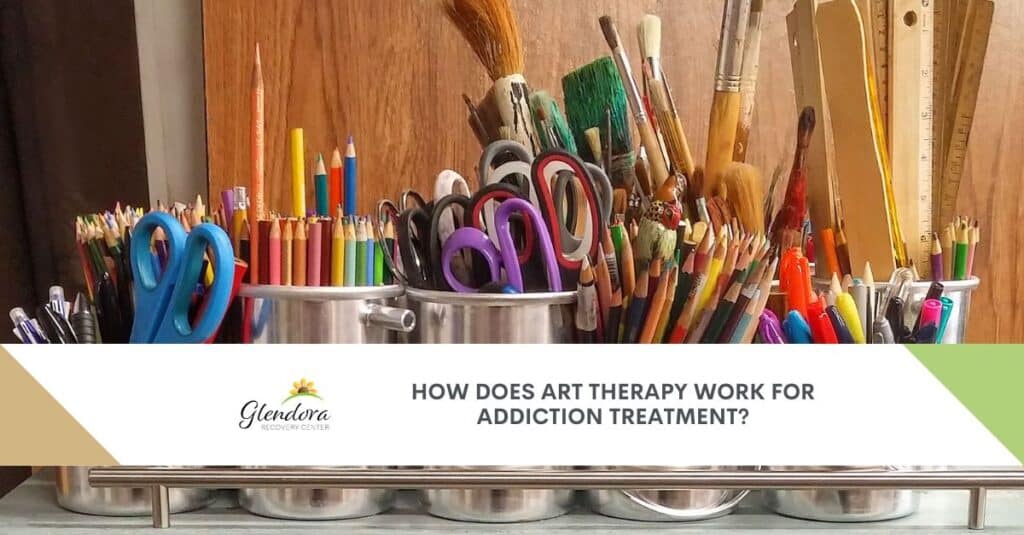Substance abuse recovery encompasses far more than simply eliminating drugs or alcohol from the body. Overcoming addiction necessarily requires an understanding of the causes of substance abuse, the motivators for recovery, and the reasons for resistance to healing. By providing an emotional outlet and a means of self-expression, art therapy serves as a vehicle for the psychological component of recovery.
Feelings or experiences that are too painful or embarrassing to express verbally can be expressed using ink, paint, clay, or other media. Art therapy can be a powerful way to promote healing when combined with other recovery services such as detox, individual therapy, support groups, and family counseling. At its core, art therapy is a form of treatment that involves the discussion or creation of art. At Glendale Recovery Center, we use art therapy to assist our patients on their road to recovery.
What Exactly Is Art Therapy?
Art therapy is a type of experiential therapy, which is a method of healing that addresses emotional and spiritual needs through creative or physical activity. One of the best things is that individuals do not need to have a background in the arts or artistic talent to participate; they simply need to be open to the experience and actively participate to benefit from these sessions. Art therapy is a relaxing and enjoyable way for many clients to address some of the more complex aspects of rehab. Some of the stressful emotions and anxieties that can arise during treatment can be processed through creative activity. Furthermore, art allows a person to convey ideas and emotions, as well as explore issues, in a way that allows that person to communicate nonverbally. Many patients are initially hesitant to discuss and explore these issues in group therapy or in conversation.
How Does It Work?
A person who is battling addiction may frequently feel as if their life is out of control, with little structure. Art therapy for addiction treatment follows rules and regulations that are relaxed, even cozy, and can provide some gentle, simple structure. Art therapy at Glendora Recovery Center can include learning the fundamentals of drawing or painting, as well as learning how light, shadow, and contrast work, among other things—all done in a non-threatening manner. This allows people to express themselves more freely.
Art Therapy Self-Esteem and Introspection
Many people who suffer from mental health disorders, such as depression, do not understand what is causing them. Art can assist such people in discovering feelings that are buried deep within their subconscious minds. The path to recovery begins with rediscovery.
Addiction creates a distorted reality about a person’s environment or circumstances but also about themselves. Many forms of art therapy can be a self-reflective exercise throughout the course of rehabilitation. As one progresses through the program, one can get in touch with the source of some of the discomfort.
Addiction is frequently caused by a lack of self-esteem. How we see ourselves determines how we act and live our lives. Art therapy creative projects will provide a sense of accomplishment and progression at the end of each completed assignment. Also, activities like drawing and coloring bring out the inner child in all of us, which can lead to depression and a desire to remember happier times.
You can express some of your innermost thoughts through the art you create during the program. For the best results, therapists use a variety of art methods such as painting, drawing, collage, and sculpture.
Finding the Best Center for You
Your sobriety is critical, which is why choosing the best California addiction recovery center is critical. Art therapy at the right center will greatly improve your chances of graduating sober and maintaining your sobriety once you return to your regular life. Making a decision, however, can be difficult due to the overwhelming number of options available, and the unfortunate reality is that some rehabs are superior to others. To make the best decision, you must first identify your needs and preferences. You can speak with one of our experts at Glendora Recovery Center to help you or a loved one identify their needs.
Art Therapy Helps Prevent Relapse
Relapse prevention is another perk of art therapy. Relapse prevention is an important aspect of rehabilitation. Once out of treatment, any number of social triggers will reappear in day-to-day scenarios. Working through these temptations through creative expression is a skill that those in recovery can use for the rest of their lives. Art therapy exercises that once helped us overcome our addictions can now help us maintain our sobriety.
A Rehab Center That Provides Art Therapy for Addiction Treatment
Art therapy for addiction treatment may not be the best option for everyone. However, for some, this will be the most effective way to tap into their creativity and then progress through their recovery. At the Glendora Recovery Center, we offer art therapy as well as a wide range of programs tailored for you.
We’re always happy to help if you’re looking for an addiction-free life or just want to learn more. The first step in your journey is the most important. You can take that step by contacting us via our website or by calling (626) 594-0881.





